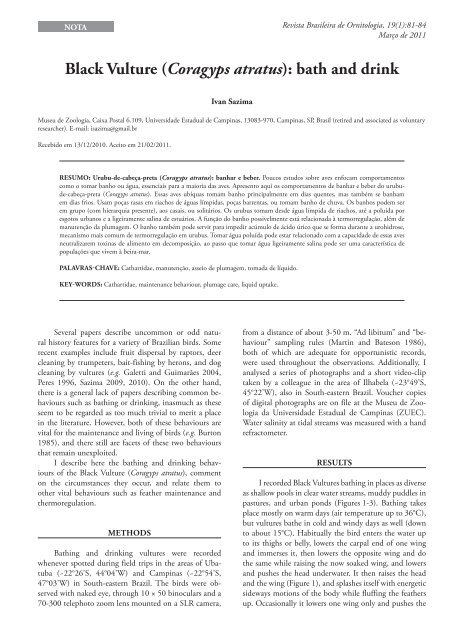Capa 19(1) - fechada.indd - Sociedade Brasileira de Ornitologia
Capa 19(1) - fechada.indd - Sociedade Brasileira de Ornitologia
Capa 19(1) - fechada.indd - Sociedade Brasileira de Ornitologia
Create successful ePaper yourself
Turn your PDF publications into a flip-book with our unique Google optimized e-Paper software.
NOTA Revista <strong>Brasileira</strong> <strong>de</strong> <strong>Ornitologia</strong>, <strong>19</strong>(1):81-84<br />
Março <strong>de</strong> 2011<br />
Black Vulture (Coragyps atratus): bath and drink<br />
Ivan Sazima<br />
Museu <strong>de</strong> Zoologia, Caixa Postal 6.109, Universida<strong>de</strong> Estadual <strong>de</strong> Campinas, 13083‐970, Campinas, SP, Brasil (retired and associated as voluntary<br />
researcher). E‐mail: isazima@gmail.br<br />
Recebido em 13/12/2010. Aceito em 21/02/2011.<br />
Resumo: Urubu-<strong>de</strong>-cabeça-preta (Coragyps atratus): banhar e beber. Poucos estudos sobre aves enfocam comportamentos<br />
como o tomar banho ou água, essenciais para a maioria das aves. Apresento aqui os comportamentos <strong>de</strong> banhar e beber do urubu<strong>de</strong>-cabeça-preta<br />
(Coragyps atratus). Essas aves ubíquas tomam banho principalmente em dias quentes, mas também se banham<br />
em dias frios. Usam poças rasas em riachos <strong>de</strong> águas límpidas, poças barrentas, ou tomam banho <strong>de</strong> chuva. Os banhos po<strong>de</strong>m ser<br />
em grupo (com hierarquia presente), aos casais, ou solitários. Os urubus tomam <strong>de</strong>s<strong>de</strong> água límpida <strong>de</strong> riachos, até a poluída por<br />
esgotos urbanos e a ligeiramente salina <strong>de</strong> estuários. A função do banho possivelmente está relacionada à termorregulação, além <strong>de</strong><br />
manutenção da plumagem. O banho também po<strong>de</strong> servir para impedir acúmulo <strong>de</strong> ácido úrico que se forma durante a urohidrose,<br />
mecanismo mais comum <strong>de</strong> termorregulação em urubus. Tomar água poluída po<strong>de</strong> estar relacionado com a capacida<strong>de</strong> <strong>de</strong> essas aves<br />
neutralizarem toxinas <strong>de</strong> alimento em <strong>de</strong>composição, ao passo que tomar água ligeiramente salina po<strong>de</strong> ser uma característica <strong>de</strong><br />
populações que vivem à beira-mar.<br />
Palavras-Chave: Cathartidae, manutenção, asseio <strong>de</strong> plumagem, tomada <strong>de</strong> líquido.<br />
Key-Words: Cathartidae, maintenance behaviour, plumage care, liquid uptake.<br />
Several papers <strong>de</strong>scribe uncommon or odd natural<br />
history features for a variety of Brazilian birds. Some<br />
recent examples inclu<strong>de</strong> fruit dispersal by raptors, <strong>de</strong>er<br />
cleaning by trumpeters, bait-fishing by herons, and dog<br />
cleaning by vultures (e.g. Galetti and Guimarães 2004,<br />
Peres <strong>19</strong>96, Sazima 2009, 2010). On the other hand,<br />
there is a general lack of papers <strong>de</strong>scribing common behaviours<br />
such as bathing or drinking, inasmuch as these<br />
seem to be regar<strong>de</strong>d as too much trivial to merit a place<br />
in the literature. However, both of these behaviours are<br />
vital for the maintenance and living of birds (e.g. Burton<br />
<strong>19</strong>85), and there still are facets of these two behaviours<br />
that remain unexploited.<br />
I <strong>de</strong>scribe here the bathing and drinking behaviours<br />
of the Black Vulture (Coragyps atratus), comment<br />
on the circumstances they occur, and relate them to<br />
other vital behaviours such as feather maintenance and<br />
thermoregulation.<br />
Methods<br />
Bathing and drinking vultures were recor<strong>de</strong>d<br />
whenever spotted during field trips in the areas of Ubatuba<br />
(~22°26’S, 44°04’W) and Campinas (~22°54’S,<br />
47°03’W) in South-eastern Brazil. The birds were observed<br />
with naked eye, through 10 × 50 binoculars and a<br />
70‐300 telephoto zoom lens mounted on a SLR camera,<br />
from a distance of about 3‐50 m. “Ad libitum” and “behaviour”<br />
sampling rules (Martin and Bateson <strong>19</strong>86),<br />
both of which are a<strong>de</strong>quate for opportunistic records,<br />
were used throughout the observations. Additionally, I<br />
analysed a series of photographs and a short vi<strong>de</strong>o-clip<br />
taken by a colleague in the area of Ilhabela (~23°49’S,<br />
45°22’W), also in South-eastern Brazil. Voucher copies<br />
of digital photographs are on file at the Museu <strong>de</strong> Zoologia<br />
da Universida<strong>de</strong> Estadual <strong>de</strong> Campinas (ZUEC).<br />
Water salinity at tidal streams was measured with a hand<br />
refractometer.<br />
Results<br />
I recor<strong>de</strong>d Black Vultures bathing in places as diverse<br />
as shallow pools in clear water streams, muddy puddles in<br />
pastures, and urban ponds (Figures 1‐3). Bathing takes<br />
place mostly on warm days (air temperature up to 36°C),<br />
but vultures bathe in cold and windy days as well (down<br />
to about 15°C). Habitually the bird enters the water up<br />
to its thighs or belly, lowers the carpal end of one wing<br />
and immerses it, then lowers the opposite wing and do<br />
the same while raising the now soaked wing, and lowers<br />
and pushes the head un<strong>de</strong>rwater. It then raises the head<br />
and the wing (Figure 1), and splashes itself with energetic<br />
si<strong>de</strong>ways motions of the body while fluffing the feathers<br />
up. Occasionally it lowers one wing only and pushes the

















